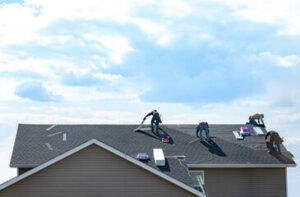Kent Roofing install, replace, and repair the roofs of buildings. They use a variety of materials, including shingles and bitumen. They also collaborate with other construction professionals.
People with this career have strong Realistic interests and tend to be independent, stable, genuine, practical, thrifty, and hardworking. They like tasks that are tactile and physically or athletically demanding.

The job duties of a roofer include building, inspecting, repairing, and replacing the roofs of residential and commercial buildings. They also help customers choose roofing materials and provide estimates for work. Roofers usually collaborate with other construction professionals to complete jobs on time and on budget. They also follow local building regulations and safety procedures when working on roofs.
The responsibilities of a roofer often require them to work at heights and may involve using ladders or scaffolding. They may also need to remove debris from the site or set up equipment such as air compressors and heaters. They may also spray roofs, sidings, and walls with material that binds, seals, insulates, or soundproofs sections of structures.
Other tasks that a roofer may perform include inspecting problem roofs to determine the best repair methods and installing or removing insulation. They may also perform maintenance tasks such as cleaning gutters, removing snow or water from the roof, and repairing leaks. Some roofers specialize in shingle installation and repairs, while others focus on metal or tile roofs.
Roofers must have good customer service skills to interact with customers and answer questions. They must also be skilled at interpreting technical plans, blueprints, or drawings. They must also have strong coordination and active listening skills to communicate with team members during the planning process.
A roofer must have a high level of physical strength and endurance to carry out their job duties. They also need to be able to stay calm and composed in stressful situations. They must have good problem-solving abilities and be able to make quick decisions in emergency situations.
The job responsibilities of a roofer usually require them to travel to different locations to complete their work. They must also have a valid driver’s license and reliable transportation to get to and from the job site. Roofers must also attend regular safety training to keep up with industry standards. This is especially important because they frequently work at high elevations. In addition, they must be knowledgeable about proper ladder usage and fall protection techniques.
Roofers need occupationally relevant education and training. This can be obtained through a high school program, college courses or apprenticeship programs. It is also possible to obtain the skills through on the job training and experience. In addition, they need to have good physical fitness, be willing to learn and follow instructions. These jobs require the use of hand and power tools, and they must be able to read blueprints.
Most roofers start out as helpers for experienced craft workers. They will typically get paid an hourly rate while they are learning the trade. Once they are fully trained, they will be given a journeyperson certificate. The length of time that a roofer or shingler will take to complete the apprenticeship will depend on their location and the type of roofing they are going to specialize in. Related work experience can reduce the amount of time required to become a qualified roofer.
Depending on where they live, roofers may have to register with their state’s construction contractors board. This will include providing proof of insurance and a surety bond. Some states also require roofers to pass an exam and be certified. This certification can be used to demonstrate that they have the necessary skills to perform their job and are following state safety regulations.
In addition, roofers need to have a strong focus on safety. They must wear protective clothing and follow the safety instructions provided by their employer. They must also keep their tools and equipment properly maintained to prevent injuries to themselves or others.
Those who work as roofers should consider obtaining certifications such as the CERTA certification and the NFPA 10 fire-safety course. The CERTA certification is intended for contractors who use torches and trains them on the proper ways to use these tools. The NFPA fire-safety course is designed to teach workers about the hazards of using flames on roofing and how to avoid them.
Compared to most occupations, Roofers tend to have a very high Realistic interest. They prefer practical and hands-on activities, like working with plants, animals or real-world materials such as wood and tools.
Roofer salaries vary greatly based on location, with some states having higher or lower average annual incomes for this professional. These variations are a result of factors such as cost of living, local demand, and industry averages. For roofing businesses owners, knowing which states pay the highest wages for a roofer can help them better plan their employee compensation packages.
The definition of a “roofer” can be somewhat vague, depending on the individual’s occupation and experience. A roofer may be a licensed roofing contractor who runs their own business, a general contractor who also performs roof work, or an unlicensed worker that works for a company. The term can also refer to a person who simply works on roofs and doesn’t necessarily need any formal training.
Regardless of the specific definition of a roofer, many individuals can find ways to increase their salary potential. This can include changing jobs, becoming certified in a specialty field, or developing a management role that oversees the work of other roofers.
There are a number of other jobs that are similar to Roofer, some of which have significantly higher salary ranges. Some examples of these other job titles are Roofer Apprentice, Sheet Metal Roofer, and Commercial Roofer. To get a more accurate picture of the salary landscape for these roles, it is worth exploring their job postings on sites such as ZipRecruiter.
Overall, the average Roofer salary is $52,142. This is slightly above the national average and indicates that there is some room for wage advancement within this role. However, only a small percentage of cities have salaries that are significantly higher than this, with San Francisco and Vallejo leading the pack.
Once the subfloor is in place, the underlayment can be installed. The type of underlayment used depends on the floor covering you’re choosing, but it generally differs from one soft or hard material to another. It can be as simple as foam padding, or more complicated cork underlayment with built-in moisture and vapor barriers that are good for areas with a high humidity level.
A thin layer of underlayment can make a huge difference in the quality of your hardwood floor installation. It will dampen noise, help prevent moisture and vapor infiltration that can cause mildew or mold, and keep the floor feeling softer for longer. Foam and cork underlayment can also smooth out rough patches in the floor, including barely protruding screw holes and knots. They’re a great choice for older homes, or in cases where the underflooring may have been damaged during a prior renovation. Felt underlayment is the most common option, and it’s easy to install. It offers basic sound absorption and moisture resistance, and is a good choice for homeowners on a budget.
Almost any part of your house gets assaulted by wind, rain, snow, ice, harsh sunlight, and other weather extremes, but the roof typically takes the brunt of the beating. A well-designed and properly installed roof will be able to withstand these conditions, but your landscaping can also help keep water off the surface of your home, away from its foundation. When soil stays too wet, it erodes its top layer washing away important nutrients and causing structural damage to your home’s foundation. Landscaping drainage solutions like catch drains or underground drainage systems can help solve these problems and prevent them from reoccurring. These can be designed into swales, gardens, and other features that make your yard beautiful as well as functional.




